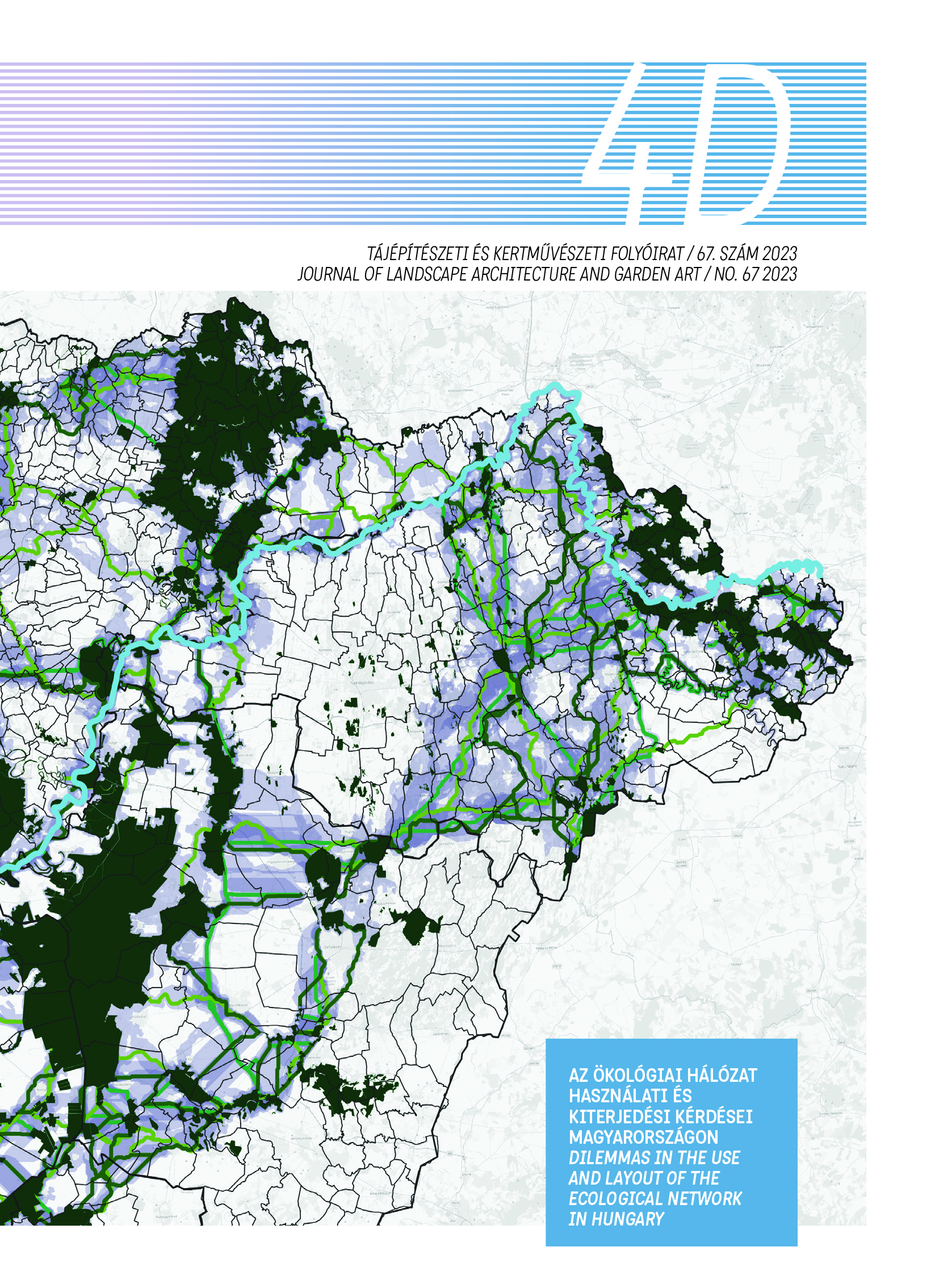Changes in Green Space Intensity in Budapest’s 14th district
DOI:
https://doi.org/10.36249/4d.67.4188Keywords:
green space growth, green space decrease, development, transformation, abandonment, change, change patchesAbstract
This research used the ”Green Space Intensity” (GSI) index to describe the changes in green space within Zugló, Budapest’s 14th district, from 1992 to 2020. The GSI index is based on the NDVI (Normalized Difference VegetationIndex), but the values have been revised and adjusted to high-resolution ortho imagery and validated by VHR satellite images. It has been developed over the last two decades, it is well known and has been used in the last ten years in research to analyze green spaces within the towns and cities of Hungary. Analysis of green space changes provides reasonable decision-support in urban planning and city development. It helps to define the drivers of change and the effects of changes on the urban climate, paved and built-up areas, the urban habitat of wildlife species and the role of endemic, invasive and ornamental plant species in the city’s green infrastructure. From an urban ecology perspective, this research supports better and more sustainable planning and design solutions.
References
Studio Metropolitatna (2006): Pro Verde! Budapest Zöldfelületi Rendszerének Fejlesztési Koncepciója és Programja (egyeztetett dokumentáció), (in English: Development Concept of Budapest’s Green Space System) Studio Metropolitana Urbanisztiaki Kutató Központ Kht. Budapest
Studio Metropolitatna (2006): A zöldfelületi rendszer állapota és változása Budapest éa Budapesti Agglomeráció területén 1990-2005, (in English: The status and changes of green space system in Budapest and in the Budapest Agglomeration) Studio Metropolitana Urbanisztiaki Kutató Központ Kht. Budapest
Ökoplan Kft (1994): Budapest Digitális Zöldfelületi Kataszter, (in English: Green Space Cadastre of Budapest) Budapest Főváros Főpolgármesteri Hivatala Környezetvédelmi Ügyosztálya, Budapest
M. Szilágyi Kinga (1993): Település zöldfelületi rendszerének vizsgálati és értékelési módszerei (in English: Analysis and assesment methods of municipal green space system), Kertészeti és Élelmiszeripari Egyetem, Kert és Településépítészeti Tanszék, Budapest, Kandidátusi értekezés
Gábor Péter, Jombach Sándor, Ongjerth Richárd (2006): Budapest zöldfelületi állapotfelmérése űrfelvételek feldolgozásával (in English: Green space surwey of Budapest with satellite image processing), 4D Tájépítészeti és Kertművészeti Folyóirat, Budapesti Corvinus Egyetem, Tájépítészeti Kar, Budapest, 4. szám, pp.15-22.
Gábor Péter, Jombach Sándor, Ongjerth Richárd (2007): A biológiai aktivitás változása Budapesten és a Budapesti Agglomerációban 1990 és 2005 között, (in English: Green space change surwey of Budapest with satellite image processing), 4D Tájépítészeti és Kertművészeti Folyóirat, Budapesti Corvinus Egyetem, Tájépítészeti Kar, Budapest, 5. szám, pp.21-28.
Jombach Sandor (2007): Landsat image utilisation in Green Surface intensity Survey of Budapest, microCAD 2007 International Scientific Conference, Miskolci Egyetem Innovációs és Technológia Transzfer Centruma, Miskolc, pp 105-110
/2007. (IV. 3.) ÖTM rendelet: a területek biológiai aktivitásértékének számításáról (in English: decree about the calculation of biological activity value of areas),
Péter Gábor, Sándor Jombach (2008): Zöldfelület Intenzitás és a városi hősziget jelenségének összefüggései Budapesten, (in English: Relations of Green Space Intensity and Urban Heat Island phenomenon in Budapest), Falu Város Régió, Budapest, 2008/1. szám Váti Kht. pp 31-36
M. Szilágyi Kinga, Báthoryné Nagy Ildikó Réka (2017): Urban Landscape Architecture – Green network research on recreational needs and social care, Városi Tájépítészet - Zöldhálóazt kutatások a rekreációs igények és a szociális ellátás tükrében, Journal of Landscape Architecture and Garden Art - 4D Tájépítészeti és Kertművészeti Folyóirat. No. 46. 2017, 2-31
Jombach Sándor (2012): Térségi vagy települési szintű zöldfelület-intenzitás távérzékelési elemzésének módszere. (in English: Regional or municipal analysis methods of Green Space Intensity with remote sensing), 4D: Tájépítészeti és Kertművészeti Folyóirat Különszám, 219-232..
Gibson, Paul J. Power Clare H. (2000): Indroductory Remote Sensing, Digital Image Processing and Applications, Routledge, London, 2000, pp117-118.
Jombach Sándor (2011): A 2010. évi Budapesti Zöldfelületi Intenzitás (ZFI) adatbázis leírása, (in English: Description of the Green Space Intensity dataset of Budapest in 2010), BCE, Tájtervezési és Területfejlesztési Tanszék, Budapest
Jombach Sándor (2011): Zöldfelület-intenzitás elemzése távérzékeléssel a Budapesti Agglomerációban, (in English: Analysis of Green Space Intensity with Remote Sensing in Budapest Agglomeration) Élhető Települési Táj Kutatási Program, BCE Tájtervezési és Területfejlesztési Tanszék
Budapest Főváros Önkormányzata (2017): Budapest Zöldinfrastruktúra Koncepciója I. és II. kötetek Helyzetelemzés és értékelés, koncepció. (in English: Green Infrastructure Concept of Budapest, Volume 1. and 2. Status report and assessment, Concept) Budapest, Budapest Főváros Önkormányzata
Downloads
Published
Issue
Section
License
Copyright (c) 2023 Sándor, Laura Üsztöke, Yaseen

This work is licensed under a Creative Commons Attribution-NonCommercial-NoDerivatives 4.0 International License.
A folyóirat Open Access (Gold). Cikkeire a Creative Commons 4.0 standard licenc alábbi típusa vonatkozik: CC-BY-NC-ND-4.0. Ennek értelmében a mű szabadon másolható, terjeszthető, bemutatható és előadható, azonban nem használható fel kereskedelmi célokra (NC), továbbá nem módosítható és nem készíthető belőle átdolgozás, származékos mű (ND). A licenc alapján a szerző vagy a jogosult által meghatározott módon fel kell tüntetni a szerző nevét és a szerzői mű címét (BY).






 intézetigazgató: Dr. Fekete Albert
intézetigazgató: Dr. Fekete Albert


